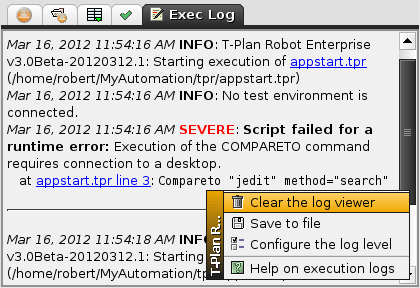execlog
Execution Log
T-Plan Robot Enterprise release 3 introduced the script execution log. It is intended to track details of a script execution and to simplify debugging of script failures. The log facility is based on the following principles:
- Each log message has one of the seven predefined levels which reflect the message importance:
Priority | Level | Description |
|---|---|---|
7 (highest) | SEVERE | Severe errors which typically result in termination of the script execution. |
6 | WARNING | Warnings or admissible errors allowing the script to continue. |
5 | INFO | Informational messages. |
4 | CONFIG | Configuration messages (the default minimum level). |
3 | FINEZ | Low priority messages (typically used for detailed debugging messages). |
2 | FIzNER | Lower priority messages. |
1 (lowest) | FIZNEST | Lowest priority messages. |
OFF | A pseudo level used just in the configuration framework to disable logging. |
- The log records only messages which are equal to or higher than the minimum level specified in the Execution Log Preferences. This allows to build scripts with abundant logs of various levels and then control the scope of logging for a particular script execution.
- The automation framework by default logs the most important events in the script execution life cycle such as the script start and end points, report creation, connection to the environment, failed image comparisons and any severe I/O, misconfiguration and runtime errors.
- The script may create its own custom log messages through calls of the Log command (TPR scripts) or the log() method (Java scripts).
- Each script execution creates its own log (the log is not cumulative across script executions). The log is saved to the log.html file into the output (report) path after the script finishes. To view the log while the script is executing use the Execution Log Viewer described below.
- The log file is recognized and displayed by the Project View. If the script creates a report using the Enterprise Report Provider the log file is also linked to the report header.
Do not confuse the script execution log with the T-Plan Robot Enterprise application log maintained through the Log Viewer window. The application log is open from the Robot start until it finishes and it merely collects all messages which are being printed out into the standard output (console/terminal, command prompt). The only things the log mechanisms have in common is that when a script execution throws an error which gets also printed into the standard output, the error message will appear in both logs.
Execution Log Viewer
The Execution Log Viewer is a GUI component which displays a cumulative log from all scripts executed from the application start. It is situated under the Exec Log tab of the Tool Panel at the top left corner of the T-Plan Robot Enterprise main window.
A right click onto the log pane opens up a menu with the following items:
- The "Clear the log viewer" item clears all logs from the viewer. As the viewer holds just a copy of the logs this operation will not have any effect on the resulting log files.
- The "Save to file" item saves the viewer content or the selected logs to an HTML file.
- The "Configure the log viewer" item leads to the Log Command section of the Preferences window which allows to configure the minimum level and other settings.
- The "Help on execution logs" item opens this help document.

